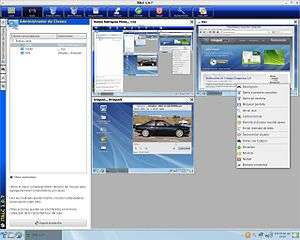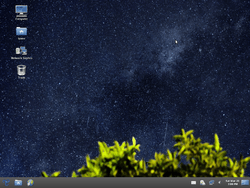Trisquel
 | |
| Developer | The Trisquel Project[1] and Sognus, S.L.U. |
|---|---|
| OS family | Unix-like |
| Working state | Current[2] |
| Initial release | January 30, 2007 |
| Latest release | 7.0[3] / November 3, 2014 |
| Marketing target | Home users, small enterprises and educational centers[1] |
| Update method | APT |
| Package manager | dpkg |
| Platforms | IA-32, x86-64 |
| Kernel type | Monolithic (Linux-libre[4]) |
| Userland | GNU Core Utilities |
| Default user interface | GNOME |
| License | Exclusively free licenses per GNU Free System Distribution Guidelines (GNU FSDG)[5] |
| Official website |
trisquel |
Trisquel (officially Trisquel GNU/Linux) is a computer operating system, a Linux distribution, derived from another distribution, Ubuntu.[6] The project aims for a fully free software system without proprietary software or firmware and uses a version of Ubuntu's modified kernel, with the non-free code (binary blobs) removed.[7] Trisquel relies on user donations.[8] Its logo is a triskelion, a Celtic symbol.[9] Trisquel is listed by the Free Software Foundation as a distribution that contains only free software.[10]
Overview
Four basic versions are available.
Trisquel
The standard Trisquel distribution includes the GNOME desktop environment and graphical user interface (GUI), and English, Spanish and many other localizations on a 1.5GB DVD image.
Trisquel Mini
Trisquel Mini is an alternative to mainline Trisquel, designed to run well on netbooks and older hardware. It uses the low-resource environment LXDE and lightweight GTK+ and X Window System alternatives to GNOME and Qt-KDE applications.[11] The LXDE desktop also includes English and Spanish localizations, and can install from a 500 MB CD image.
If an Internet connection is enabled while installing Trisquel or Trisquel Mini, the software will download and install itself, including user menus and all available documentation, in any one or more of the languages in which it has been localized.
Trisquel Sugar TOAST
Sugar is a free and open source desktop environment designed with the goal of being used by children for interactive learning. Sugar replaces the standard GNOME desktop environment available with Trisquel.
Trisquel NetInstall
Consists of a 25MB CD iso image with just the minimal amount of software to start the installation via a text based network installer and fetch the remaining packages over the Internet.
Internationalization
The full installation includes 51 languages (Albanian, Arabic, Aranese, Asturian, Basque, Bulgarian, Catalan, Central Khmer, Simplified Chinese, Traditional Chinese, Croatian, Czech, Danish, Dutch, English, Esperanto, Estonian, Finnish, French, Galician, German, Greek, Hebrew, Hindi, Hungarian, Indonesian, Irish, Italian, Japanese, Korean, Latvian, Lithuanian, Low German, Norwegian Bokmål, Norwegian Nynorsk, Occitan, Punjabi, Polish, Portuguese, Romanian, Russian, Serbian, Slovak, Slovenian, Spanish, Swedish, Tamil, Thai, Turkish, Valencian and Vietnamese) pre-installed in a downloadable 1.2-gigabyte DVD image.
Full source code for the full Trisquel installation is also available in a downloadable 3-gigabyte DVD image.
History
The project began in 2004 with sponsorship of the University of Vigo for Galician language support in education software and was officially presented in April 2005 with Richard Stallman, founder of the GNU Project, as a special guest.[12] According to project director Rubén Rodríguez, the support for Galician has created interest in South American and Mexican communities of emigrants from the Province of Ourense.[13]
By December 2008, Trisquel was included by the Free Software Foundation (FSF) in its list of Linux distributions endorsed by the Free Software Foundation.[14]
Release history
| Legend: | Old version | Older version, still supported | Current stable version |
|---|
| Version | Code name | Release date | Supported until | Kernel | Desktop environment | Based on |
|---|---|---|---|---|---|---|
| 1.0 | Arianrhod | 2007-01-30[15] | N/A | Linux 2.6.18.6 | GNOME 2.14 | Debian 4.0 (Etch) |
| 2.0 LTS | Robur | 2008-07-24[16] | 2014-03-02[17][18] | Linux 2.6.24 | GNOME 2.22 | Ubuntu 8.04 LTS (Hardy Heron) |
| 3.0 STS | Dwyn | 2009-09-08[19] | 2011-05-11[17][20] | Linux-libre 2.6.28 | GNOME 2.26 | Ubuntu 9.04 (Jaunty Jackalope) |
| 3.5 STS | Awen | 2010-03-22[21] | 2011-07-14[17][22] | Linux-libre 2.6.31 | GNOME 2.28 | Ubuntu 9.10 (Karmic Koala) |
| 4.0 LTS | Taranis | 2010-09-18[23] | 2015[24] | Linux-libre 2.6.32 | GNOME 2.30 | Ubuntu 10.04 LTS (Lucid Lynx) |
| 4.5 STS | Slaine | 2011-03-24[25] | 2012-09-15[17][26] | Linux-libre 2.6.35 | GNOME 2.32 | Ubuntu 10.10 (Maverick Meerkat) |
| 5.0 STS | Dagda | 2011-09-17[27] | 2014-03-02[17][18] | Linux-libre 2.6.38 | GNOME 2.32 | Ubuntu 11.04 (Natty Narwhal) |
| 5.5 STS | Brigantia | 2012-04-16[28] | 2014-03-02[17][18] | Linux-libre 3.0 | GNOME 3.2 | Ubuntu 11.10 (Oneiric Ocelot) |
| 6.0 LTS | Toutatis | 2013-03-09[29] | 2017[29] | Linux-libre 3.2 | GNOME 3.4 | Ubuntu 12.04 LTS (Precise Pangolin) |
| 7.0 LTS | Belenos | 2014-11-03[30] | 2019[30] | Linux-libre 3.13 | GNOME 3.12 | Ubuntu 14.04 LTS (Trusty Tahr) |
| 8.0 LTS | Flidas[31] | TBA | TBA | TBA | TBA | Ubuntu 16.04 LTS (Xenial Xerus) |
The releases that use GNOME 3.x use GNOME Classic/Flashback, rather than the default GNOME Shell. All Trisquel releases starting with version 6 are only based on Ubuntu LTS releases.[32]
Current versions include this common software:
- Abrowser, a rebranded version of Firefox that never suggests non-free add-ons, and includes no trademarked art or names. It is rebranded because the Mozilla Trademark Policy forbids modifications that include their trademark without consent.[33]
- Gnash, a SWF viewer, instead of Adobe Flash Player, which is proprietary software.[34]
Prior editions:

- Trisquel Pro was business-oriented and small. It was part of the Trisquel 2.0 LTS Robur (2008), but no other release followed.[35]
- Trisquel Edu was education-oriented, for schools and universities. Like Trisquel Pro, no other release followed Trisquel 2.0 Robur (2008).[36]
- Trisquel on Sugar was education-oriented, based on the Sugar desktop environment for interactive learning for children. It was released at the same time as Trisquel 7.
- Trisquel Gamer was an independent edition maintained by David Zaragoza. It included 55 free software games and could boot from a live DVD or USB drive. It was released with Trisquel 3.5 (2010), which is no longer supported.[37]
Reception

Jesse Smith of DistroWatch reviewed the 4.0 release, Taranis, and described it as refined and dependable. He portrayed difficulty with removing software as his main problem with the release. He complimented it as an operating system that showcased utility instead of mere compliance with free software criteria.[6]
Jim Lynch of Desktop Linux Reviews reviewed the 5.5 release, Brigantia, and described it as "well-ordered and well developed" and recommended it to users whether they care about only using free software or not. Lynch stated that the release was suitable for beginners and advanced users.[38]
Chris Fisher and Matt Hartley of the The Linux Action Show! praised the design, ease of use, and hardware support of Trisquel 5.5 and Trisquel 5.5 Mini, but found that the Linux-libre kernel found in Trisquel impedes functionality of proprietary wireless devices. They argued that the distribution was targeting power users and that new users should use a different distribution.[39]
Richard Stallman announced in January 2015 that he is using Trisquel on a Thinkpad X60 instead of his former computer the Lemote Yeeloong.[40]
Hardware
IA-32 and x86-64 CPU architectures are supported since Trisquel 5.5, which includes free software compatible chipsets.[41]
See also
- Comparison of Linux distributions
- List of Linux distributions based on Ubuntu
- GNU/Linux naming controversy
References
- 1 2 "Trisquel GNU/Linux - Run free!". trisquel.info. Retrieved 8 November 2015.
- ↑ "Download - Trisquel GNU/Linux - Run free!". trisquel.info. Retrieved 24 May 2015.
- ↑ "Trisquel 7.0 LTS Belenos". trisquel.info. Retrieved 24 May 2015.
- ↑ "Documentation | Trisquel GNU/Linux - Run free!". Retrieved 2016-03-05.
- ↑ "List of Free GNU/Linux Distributions - GNU Project - Free Software Foundation". gnu.org. Retrieved 24 May 2015.
- 1 2 Smith, Jesse (October 4, 2010). "Trisquel GNU/Linux - a free distribution". DistroWatch. Retrieved September 13, 2012.
- ↑ "How Trisquel is Made". Trisquel.info. Retrieved May 12, 2015.
- ↑ "Siete factores antes de usar 'software'" (in Spanish). El Comercio. April 14, 2012. Retrieved September 13, 2012.
- ↑ "How is "Trisquel" pronounced?". The Trisquel Project. Retrieved September 14, 2012.
- ↑ "List of Free GNU/Linux Distributions". Retrieved 13 May 2014.
- ↑ "Trisquel Mini". The Trisquel Project. Retrieved September 13, 2012.
- ↑ "Richard Stallman, defensor del software libre, sorprendió a los universitarios" (in Spanish). La Voz de Galicia. April 28, 2005. Retrieved November 26, 2008.
- ↑ García, Ana (May 17, 2007). "Software libre da terra, compartindo cultura" (in Galician). El Progreso. Retrieved September 13, 2012.
- ↑ "Free GNU/Linux distributions". Free Software Foundation. Retrieved September 13, 2012.
- ↑ Trisquel (January 30, 2007). "Publicación de Trisguel 1.0" (in Galician). Archived from the original on February 3, 2007. Retrieved August 3, 2014.
- ↑ "Proxecto Trisquel" (in Galician). July 24, 2008. Archived from the original on July 24, 2008. Retrieved August 3, 2014.
- 1 2 3 4 5 6 "Index of /trisquel/dists". Retrieved August 4, 2014.
- 1 2 3 "[Trisquel-announce] [Trisquel-devel] Robur, Dagda and Brigantia moved to oldarchive". March 2, 2014. Retrieved August 3, 2014.
- ↑ "Trisquel 3.0 STS "Dwyn" has landed!". The Trisquel Project. September 8, 2009. Retrieved August 3, 2014.
- ↑ "[Trisquel-announce] Trisquel 3.0 STS Dwyn reaches end of life, 3.5 soon to follow". May 11, 2011. Retrieved August 3, 2014.
- ↑ "Trisquel 3.5 Awen release announcement". The Trisquel Project. March 22, 2010. Retrieved August 3, 2014.
- ↑ "[Trisquel-devel] Trisquel 5.0 development repository up, 3.5 reaches end of life". July 15, 2011. Retrieved August 3, 2014.
- ↑ "Trisquel 4.0 LTS "Taranis" strikes!". The Trisquel Project. September 18, 2010. Retrieved August 3, 2014.
- ↑ "Versions". Retrieved August 3, 2014.
- ↑ "Trisquel 4.5 "Slaine" released". The Trisquel Project. March 24, 2011. Retrieved August 3, 2014.
- ↑ "[Trisquel-announce] Trisquel 4.5 Slaine reached end of life". September 15, 2012. Retrieved August 3, 2014.
- ↑ "Trisquel 5.0 Release announcement". The Trisquel Project. September 17, 2011. Retrieved August 3, 2014.
- ↑ "Trisquel 5.5 STS Brigantia release announcement". The Trisquel Project. April 16, 2012. Retrieved August 3, 2014.
- 1 2 "Trisquel 6.0 LTS "Toutatis" has arrived!". The Trisquel Project. March 9, 2013. Retrieved August 3, 2014.
- 1 2 "Trisquel 7.0 LTS Belenos". The Trisquel Project. November 3, 2014. Retrieved November 3, 2014.
- ↑ "Update config file for next Trisquel release". Trisquel at Gitlab. February 22, 2016. Retrieved February 23, 2016.
- ↑ "2013-03-05 Meeting". Trisquel. March 5, 2013. Retrieved November 29, 2014.
- ↑ "Mozilla Trademark Policy". Mozilla. October 30, 2009. Retrieved December 19, 2012.
- ↑ Baader, Hans-Joachim (September 20, 2011). "Trisquel 5.0 veröffentlicht" [Trisquel 5.0 published] (in German). Pro-Linux. Retrieved September 13, 2012.
- ↑ "Trisquel Pro". The Trisquel Project. Retrieved December 19, 2012.
- ↑ "Trisquel Edu". The Trisquel Project. Retrieved September 13, 2012.
- ↑ Zaragoza, David. "Trisquel Gamer". The Trisquel Project. Retrieved September 13, 2012.
- ↑ Lynch, Jim (April 24, 2012). "Trisquel 5.5". Desktop Linux Reviews. Retrieved April 28, 2012.
- ↑ Fisher, Chris; Hartley, Matt (September 2, 2012). "Trisquel GNU/Linux Review - LAS - s23e05". Jupiter Broadcasting. Retrieved September 13, 2012.
- ↑ Stallman, Richard. "Richard Stallman's personal site - How I do my computing". Retrieved January 6, 2015.
- ↑ "ThinkPenguin". trisquel.info. Retrieved 24 May 2015.
External links
| Wikimedia Commons has media related to Trisquel. |